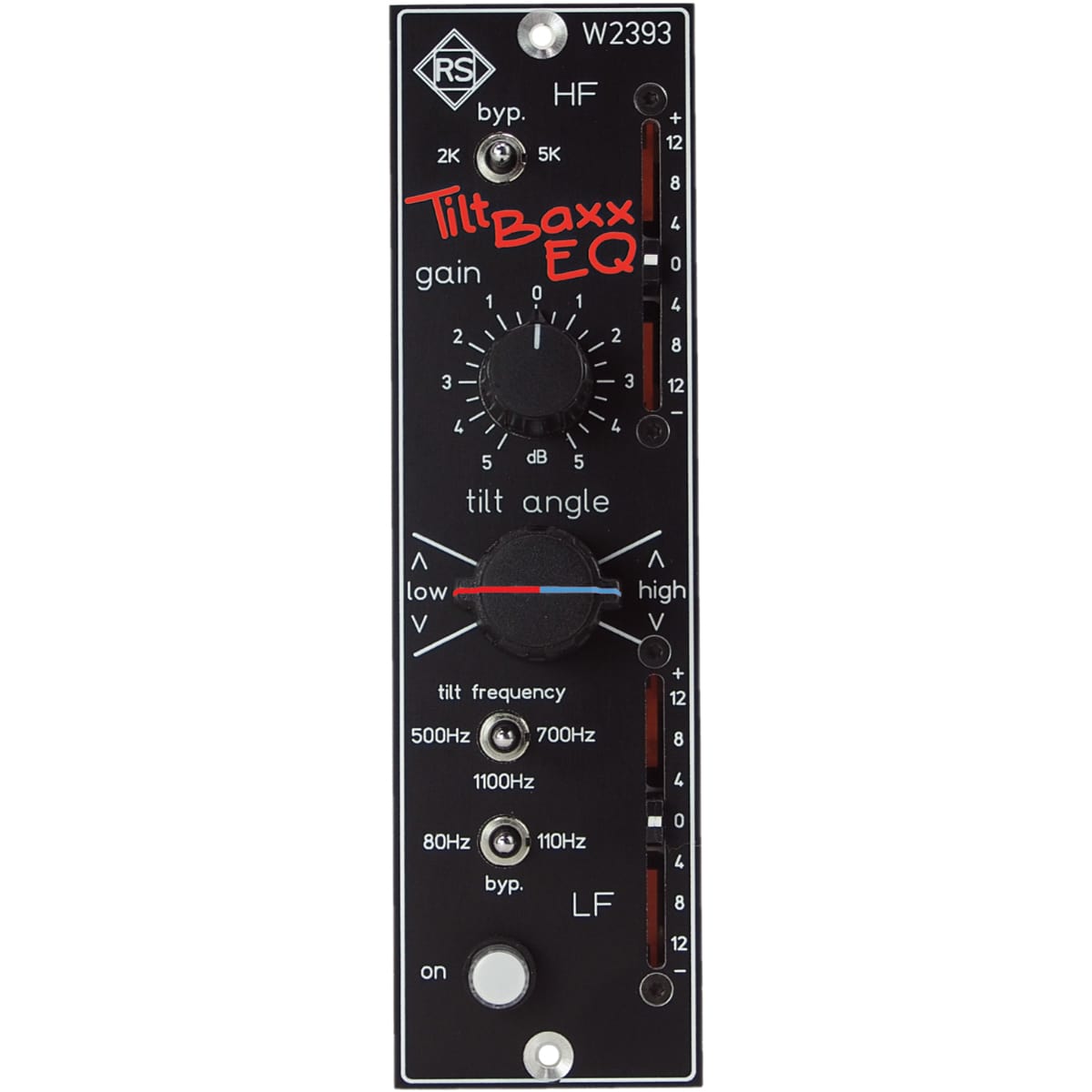Outboard devices are analog or digital signal processors and are used both in the recording studio and in live operation. Due to their specific sound characteristics, they are often used to refine signals or as a central unit to control monitors, input sources and routing options. Depending on the manufacturer and series, these devices are offered in different formats, such as 19″ or 500 modules. Outboard gear is popularly used in recording, mixing and mastering and is often optimized for one of the specialties due to certain features.
-
Weiss A1 Preamp & DeEsserRated 0 out of 51.790€
- Mic Preamp with 60dB Ultra Clean Gain
- DeEsser with Solo Listen
- -24 dB Pad for Line-Level
- +27dBu Headroom
-
Lindell Audio LiNTEC – Vintage Program EqualizerRated 0 out of 5499€
- Passive equaliser in Pultec style
- 5-step bass frequency selection (boost/cut)
- 11-step treble frequency selection (boost)
- 5-step treble frequency selection (cut)
-
Avalon V55 | High Voltage Dual PreampRated 0 out of 53.999€
- High Voltage Design
- DI und Re-Amping
- for microphones and instruments
- Dual impedance for ribbon/condenser microphones
-
IGS Audio Volfram Limiter | 1176 / 1178 FET CompressorRated 0 out of 51.899€
- FET Compressor / Limiter 1176 / 1178 Style
- Wet/Dry Mix
- Internal Sidechain-Filter
- Dual Mono with Stereo-Link
-
IGS Audio One LA 500 | Opto Compressor/LimiterRated 0 out of 5939€
- Opto-Compressor in LA2A Style
- IGS Audio Custom Transformer
- T4Bx photocell
- 250V DC full tube device
-
IGS Audio One Leveling Amplifier | Opto-CompressorRated 0 out of 51.590€
- Opto-Kompressor in LA2A Style
- IGS Audio 2510 transformers
- T4Bx photocell
- 6N2P-EW Triode and 6AQ5 Pentode
-
IGS Audio Zen | Zener Mastering Compressor/LimiterRated 0 out of 52.790€
- Modern Zener diode compressor / limiter
- based on the RS168 and TG12345 / TG12313
- Internal Sidechain-Filter
- Dual-Mono with Stereo-Link
-
IGS Audio TUBECORE | Vari-Mu Mastering CompressorRated 0 out of 52.890€
- Variable-Mu tube compressor
- IGS Custom Made Audio Transformers
- 24-stage Elma switches
- Stereo / Dual-Mono / Mid-Side
-
Audiosteps 500s rack panel | Blank panel in API 500 formatRated 0 out of 518€
- suitable for any lunchbox in API 500 format
- milled from aluminum
- 2.5mm thickness
-
API 3124V | Discrete 4 Channel PreampRated 0 out of 53.769€
- Classic API circuit design
- Uses API 2520 operational amplifier
- Variable output level control
-
Buzz Audio elixir | 500s Mic PreampRated 0 out of 5849€
- 22 – 70dB Gain – 41-stepped Potentiometer
- Impedance selector switch for Mic Gain and DI Gain
- -20dB pad and phase reverse switch
-
Roger Schult W2393 TiltBaxxEQ (B-Stock)Rated 0 out of 5
649€Original price was: 649€.599€Current price is: 599€.- Tilt Filter + Baxandall EQ
- 3 frequencies for tilt filter with +/- 5 dB
- 2 frequencies each for treble & bass band with +/- 12 dB
- Bypass for Baxandall EQ and entire module
Available in our demo studio Dresden. Arrange appointment
-
Roger Schult V2359j amp4ribbon microphone preamp silver (B-Stock)Rated 0 out of 5
829€Original price was: 829€.649€Current price is: 649€.- Microphone preamplifier
- Gain: 26 dB – 59 dB
- Impedance control: 150 Ohm to 22 kOhm
- 3-band EQ
Available in our demo studio Dresden. Arrange appointment
-
AEA RPQ3 | 2-channel JFET preamp with CurveShaper™ EQRated 0 out of 51.890€
- Two channels with 85 dB JFET gain
- Suitable for Mic & Line
- Switchable phantom power, polarity inversion and high-pass filter and CurveShaper™ EQ
- 68k-ohm circuit with high impedance for the best sound
- Optimized for ribbon, condenser and dynamic microphones
-
AEA TRP3 | 2-channel JFET preampRated 0 out of 51.579€
- Two channels with 85 dB JFET gain
- Switchable phantom power, polarity reversal and high-pass filter
- 68k-ohm circuit with high impedance for the best sound
- Optimised for ribbon microphones, condensers and dynamic microphones
- 1U half rack with optional hardware for mounting one or two devices
-
Black Lion Audio PBR XLR 32 DSub | PatchbayRated 0 out of 5559€
- 16 In- and 16 Outputs (XLR)
- 4 DB25 sockets on the rear panel (Tascam standard)
- All connections gold-plated
-
SPL Vitalizer Mk3-T 2210Rated 0 out of 51.079€
- Psychoacoustic effects
- Vitalizer® technology with demasking
- Mk3 version with higher audio voltage of +/-18V
-
SPL MixDream XP Mk2 2170 | 16-channel summing mixerRated 0 out of 51.479€
- 16-in-2 summing mixer
- Class A technology
- -18 dB level reduction for the last four stereo channels
- Number of channels can be extended as required with additional units
-
elysia mpressor2 qube | Creative Analog CompressorRated 0 out of 51.389€
- THD Boost
- Auto Fast
- Anti Log
- negative Ratios
- Gain Reduction Limiter
-
elysia karacter qube | Class-A Saturator / DistortionRated 0 out of 5899€
- Dual Mono / Stereo Link und M/S-Matrix
- Mastering-Grade Saturation
- Tube-inspired Distortion
- Color-Filter
- gridded potentiometers
-
elysia karacter | Class-A Saturator / DistortionRated 0 out of 51.219€
- Dual Mono / Stereo Link und M/S-Matrix
- Mastering-Grade Saturation
- Tube-inspired Distortion
- Color-Filter
- gridded potentiometers
-
elysia mpressor 500 | Creative Analog CompressorRated 0 out of 5639€
- THD Boost
- Auto Fast
- Anti Log
- negative Ratios
- Gain Reduction Limiter
-
elysia karacter 500 | Class-A Saturator / DistortionRated 0 out of 5805€
- Dual Mono / Stereo Link und M/S-Matrix
- Mastering-Grade Saturation
- Tube-inspired Distortion
- Color-Filter
- gridded potentiometers
-
Fairchild 670 | Tube Limiter/CompressorRated 0 out of 539.900€
- legendary tube compressor
- limited to 10 pieces / year worldwide
- Dual mono/stereo operation
- 20 vacuum tubes
-
Black Lion Audio Seventeen 500 | 1176 CompressorRated 0 out of 5639€
- FET compressor in API 500 format
- Fully discrete Class A circuit
- Sidechain-Filter: OFF, 100Hz, 200Hz
- Dry/Wet controller


















































